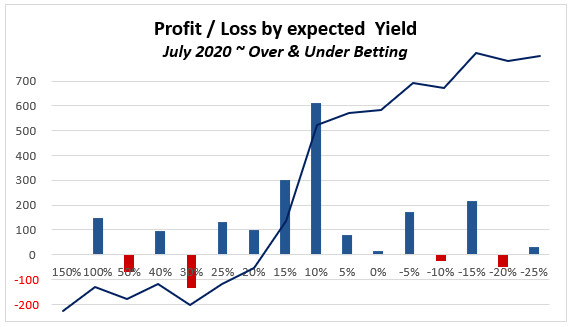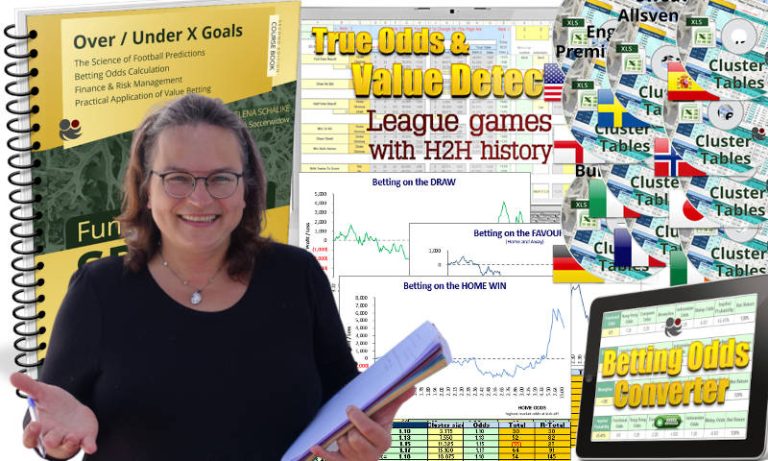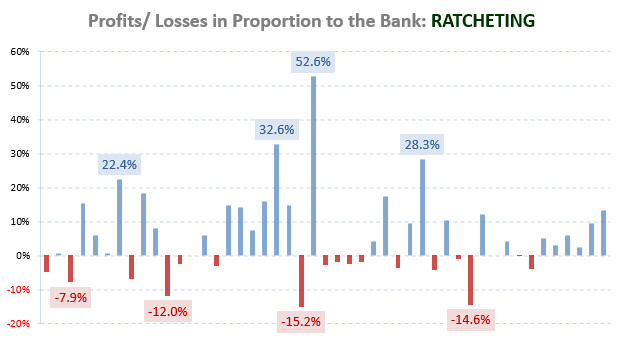
(4) A high yield is better than a small yield
If you agree with the above statement then you probably do not really understand how yield is calculated.
Definition: Profit/Loss ratio as a function of the total capital employed (total staked)
MS – money staked
ML – money lost (stakes lost)
MW – money won (purely winnings; returned stakes are ‘neutral’, not winnings)
PL – MW minus ML = net profit (or loss); equivalent to your bank growth
Formula Yield:
Example:
A player wagers 76 times @ £10, which means a total stake of £760.
Assuming he wins £70 the yield is:
Another player wagers 10 times @ £76 meaning his total stake also adds up to £760.
He wins £50, the yield for the 2nd Player is:
At face value the yield of the first player is larger than the yield of the second. However, merely from looking at the two yields it cannot be said for certain which of the two players was more successful.
Player 1 wagered 76 times to win £70. Player 2 won £50 with only 10 bets.
Suppose that the hit rate of player 1 was 60% whilst player 2 achieved 100%.
Then the smaller yield must be better? Less time was spent on betting, fewer bets were placed, but each bet won. On the other hand it was only a small sample of 10 bets, and it is not known whether this strike rate will continue.
What I want to say with this example is that no betting system, whether value betting or otherwise, can be judged or evaluated using its yield for comparison. It is impossible to say whether a higher or smaller yield is better or worse if variables of an unknown quantity exist. Yield measures betting efficiency against the total turnover. The lower a gambler’s aversion to risk, the more events of higher probability he will tend to include in his betting portfolio, but the smaller the yield will be, and vice versa.
In effect, a laying system with high probabilities of winning will produce a very tiny yield compared with a backing system at high odds which risks very small stakes with each bet for a higher yield. However, the laying system may be much more stable and profitable, and hence the better choice.
Therefore, it is important to remember that it is simply wrong to say that a higher yield indicates a better betting performance than a lower yield.
The only thing of importance is that there should be a positive yield. Of course, negative yield indicates the venture is a loss maker.
(5) It is possible to achieve a constant hit rate of 80% betting on odds between 1.5 to 3.0
This is wishful thinking of a high order unless you deal in circles where match fixing is common practice or if you can rely on any other form of insider knowledge for your value betting.
Odds of 1.5 stand for a 66.7% chance of winning the bet and odds of 3.0 for 33.3%. Assuming you balance your bets in this zone the average of the two is 50%. This means that you will observe a long-term distribution of 50% winning bets and 50% losing bets.
Anyone who seriously believes that betting on events with an average 50% probability can achieve a hit rate of 80% must perform a serious reality check. This is absolute nonsense and an impossible dream!
Conclusion: Value Betting Misconceptions
I cannot stress often enough that if you feel the desire to gamble then you must force yourself to really understand betting odds calculation. This will save you from giving away your hard earned money and give you a chance of competing with the bookmakers and exchanges on a level playing field.
Of course, mathematics is not everyone’s strength. Nevertheless, you should not be afraid to try. On Soccerwidow.com you will find a value betting course aimed at beginners introducing bettors to the basics of odds calculation: Fundamentals of Sports Betting.
Readers with intermediate skills who have already acquired some understanding of probabilities may find our value bet detector spreadsheet helpful: True Odds & Value Calculator: League games with head-to-head history.
Of course, it would also be great if readers could use the comments section below for submitting other examples of false beliefs, wrong value betting concepts and common myths within the betting community. We are always happy to respond.






Terrible Article. Horrible Advice!!!
Your 5th point is insulting to profitable bettors saying that it’s not possible. It is without a doubt certainly possible to win 80% of your bets with odds of 1.5, even more easier if you’re winning 70% of your bets which is more achievable. If you have a tennis player who is available to back at 2.05 and you believe they have a 70% chance of winning the match, and you back this kind of outcome time and time again, you will make a shed load of money just like many people are. Nothing is impossible with the right information.
Hi soccer widow,
I have purchased all three of your spreadsheets for value calculation and during the last 3 months i am running a series of screening tests which include: identifying value, place the bets and results recording.
But i have not being able yet to answer one simple question, ‘ How much value is accepted?’ . I mean is it possible to quantify the acceptable levels of the mathematical edge on which we make our bets?
While everybody is looking for value,what makes me wonder is ‘what is the bookies approach to this?
My results show that when bookmakers offer high value bets (e.g math edge over 130% ) then these bets most likely do not make profit. That make sense to me since, a bookmaker will not give away high value odds because this will destroy its profitability in the long run.
Almost 7 out of 10 bets, where value calculation is more than 150%, result in a loss. This occurs frequently in high volume matches like Champions league games or local derbies in EPL.
Therefore my question to you and the readers is :Can we safely measure the “acceptable” levels of value in our picks?
True Odds & Value Detector: League Games with H2H History
Hi Socrates,
You are asking a very good question ‘How much value is accepted?’, and your observation matches other people’s research results.
Unfortunately, you’ll have to keep playing with the strategy of your choice until you work out what works for you, and what doesn’t. For example, we have been monitoring dutch-backing HT scores for while, and for this it has to be a positive value, but not more than 30%.
Bookmakers have of course more information about the games than a normal punter, and no doubt, they’ll also have knowledge of anomalies. Therefore, if the value calculations are showing a huge value, then it may be as well a fixed match, or anything else influencing the outcome far more than statistical distribution.
Very interesting Lakoni. I am somewhere between 2nd and 3rd stage searching for best way to find value in football. I am using statistics from past 2 seasons and putting them into poisson calculations but still lacking something.
Can you please share your approach? If you do not want to do it in public I can give you my e-mail. Thank you anyway!
The punter goes in his betting-career through few stages.
1. He finds out that % of correct picks is not the most important when judging any punter’s skills. He realizes that the odds are also important.
2. He considers Yield as the only one factor which decides of skills of punter, forgetting that primary aim is to make cash. In this level, a punter doesn’t take any other factor (as number of picks) into account. Yield is the holy grail and nothing is important at all.
3. The third stage is discovering that one guy can make bigger profit in a season despite having lower yield. Paradoxically, the punter now re-realises what he had already known when started his betting career. This is that the main aim is to make cash.
I am now on this third stage and thank you Soccerwidow and your excellent explanations and tutorials. I am now making profits by placing plenty of value bet selections 🙂